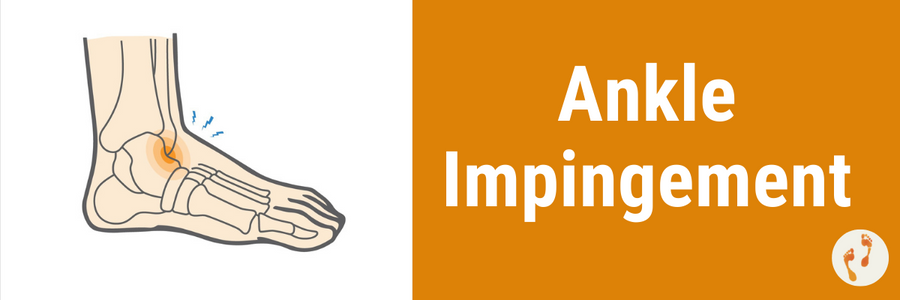 An ankle impingement or compression often causes pain at the front (anterior) or at the back (posterior) of the ankle, depending on which ankle structures are being impinged upon.
An ankle impingement or compression often causes pain at the front (anterior) or at the back (posterior) of the ankle, depending on which ankle structures are being impinged upon.
During an ankle impingement, the way the bones of the ankle move either trap, compress or abnormally contact other structures in the area, which produces pain and often restricts the movement of the ankle. An analogy for this is a nut in a nutcracker – with the nut being the structure that is compressed, and the sides of the nutcracker being the bones of the ankle that move alongside each other.
Symptoms of an ankle impingement may include:
- Pain when moving your foot a very specific way, such as pointing your toes up towards the sky, or down towards the ground.
- Sharp, dull, or radiating pain
- Your ankle feel stiff or restricted, and you may experience some ankle weakness alongside the pain
- When you relax your foot back into a neutral position, your symptoms will ease (though may not reduce completely if you have subsequent swelling or irritation), and recur more intensely when you repeat the foot movements.
Ankle impingement can be caused by a range of factors, including:
- Ankle instability – having weakened, ‘wobbly’ ankles that are more likely to compress the structures around the ankle
- Injury or trauma to the feet or ankles which can leave scar tissue or increase your likelihood of developing bone spurs
- Ankle arthritis – arthritis can cause bone degeneration, which can increase the risk of ankle impingement
- Irregular bone shapes of the talus or calcaneus bones that form the ankle
- Your foot biomechanics
- Accessory bones and bone spurs
- Soft tissue lesions
Can You Fix It?
The good news is that up to 70% of cases of ankle impingements can be fixed without any surgery. To understand the cause of your ankle impingement, your podiatrist will start by looking at where the impingement has occurred, which structures are involved, what is happening with your foot biomechanics, and any other medical factors like your injury history.
Your podiatrist will explain the results of your assessment very clearly during your appointment as it is important for you to understand in order to help prevent the problem from recurring in the future. Your assessment may involve using an x-ray or ultrasound to help identify the presence of any structures like bone spurs, changes to the joint itself, or any swelling or irritation to the surrounding soft tissues.
How Is An Ankle Impingement Treated?
After identifying the source of your impingement and why it has occurred, your podiatrist will create a custom treatment plan based on the specific problem. This may look like:
- Treating any damaged or inflamed ligaments that are being caught and impinged upon
- Ensuring your footwear is supporting your recovery and not exacerbating your symptoms from the way it positions your foot and ankle
- Addressing any problems with your foot biomechanics or positioning that may be contributing to your symptoms using custom foot orthotics
- Making permanent shoe modifications to support your comfort and recovery
- Using temporary in-shoe modifications like a heel lift
- Using a brace to support the ankle in a specific position that eases symptoms
- Helping improve the strength and stability of your ankles, as well as your proprioception
- Implementing a stretching program where muscle tightness may be contributing to your symptoms
- Teaching you strategies and exercises to care for your ankle impingement at home
- If the above treatments don’t work, your podiatrist may discuss ultrasound-guided corticosteroid injections with you, which have also been reported to have some success in studies
- Your podiatrist will also help guide you on how to return to exercise as you begin responding to treatment safely.
If you continue to experience persistent symptoms that are affecting you in daily life or sports, we can refer you to an orthopaedic surgeon for a consultation to see if surgery could help. The type of surgical procedure will vary depending on the location of your pain and your symptoms, but may include a resection or debridement of the bony lesions, soft tissues, or both. This will help restore the anterior ankle space, preventing the impingement as the ankle is moved and reducing the chances of recurring symptoms in the future.
FAQs
How long does it take to recover from an ankle impingement?
Mild cases of ankle impingement may take a few weeks to recover with rest, ice, compression, and elevation (RICE) therapy, along with physical therapy to restore mobility, strength, and flexibility. Moderate to severe cases of ankle impingement may take several weeks to several months to recover, especially if surgery or invasive treatments are required.
Can an ankle impingement cause long-term complications?
Yes, untreated ankle impingements can lead to ongoing complications like chronic pain, a greater likelihood of arthritis development, ankle instability, reduced mobility and function, and ongoing impingement recurrence.
Are there any exercises or physical therapy that can help with an ankle impingement?
Depending on the cause of the impingement, physical therapy and exercises can be an important part of the recovery process and may involve a range of motion exercises, strengthening exercises, proprioceptive trailing, mobilisation therapy and more.
Can an ankle impingement be prevented?
In many cases, ankle impingements cannot be prevented, but to reduce your likelihood, ensure to wear good supportive footwear, perform warm-ups and stretches prior to physical activity, maintain good technique and form during physical activity, and don’t leave any injuries or problems such as ankle instability unaddressed.
